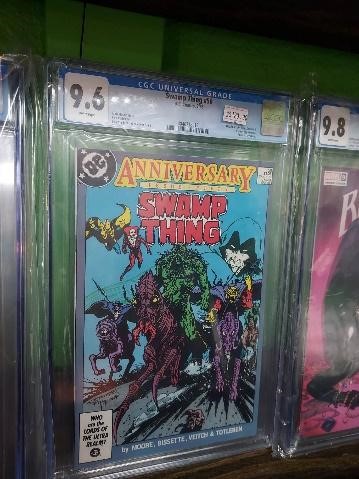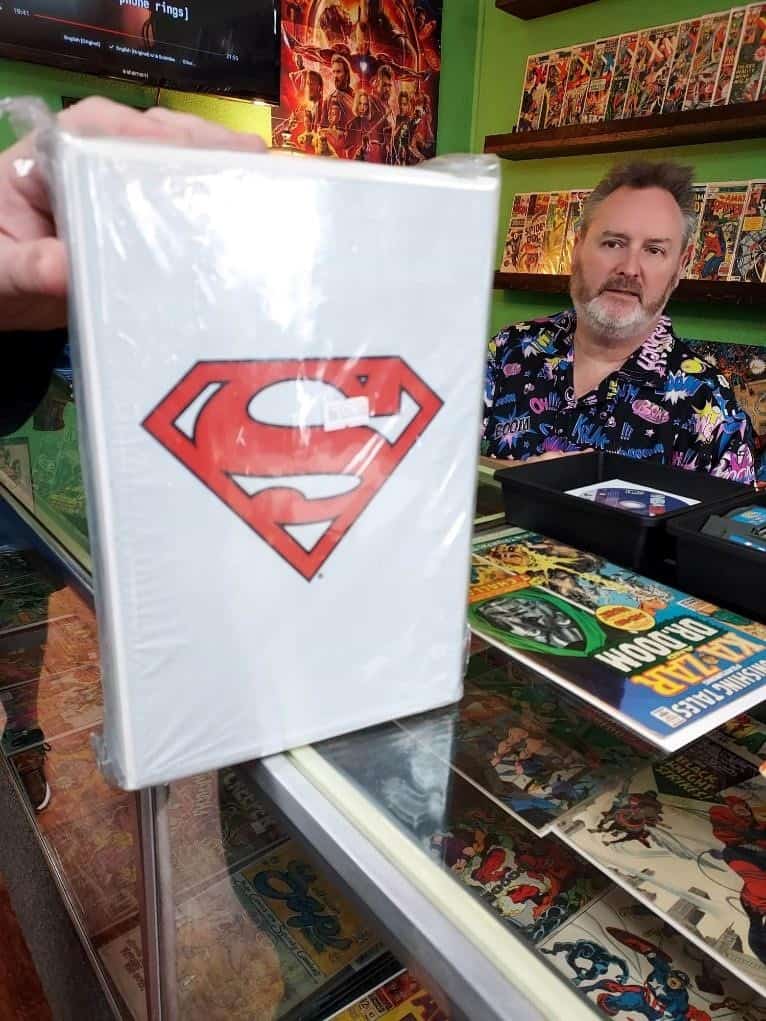A person can delve into collecting comics for so many reasons: the art, the story, the variety, the history, and the drama. Yes, there is almost as much excitement and thrills to the hobby, or livelihood, of comic collecting as the comics themselves! Even the conversations based around them are endless and ever changing. But for the sake of article brevity, we will scratch the surface of one basic topic: What’s all this about a ‘graded’ comic?
For many questions, I turn to the comics community. It’s huge, world-wide, and you can find camaraderie and join the excitement online or in person. But for journalistic purposes, I turn to the experts, so I paid a visit to My Guys Comics in Clinton, Tennessee. They are four life-long collectors and fans that came together to create their own shop and livelihood from their passion: Bryan Emert, Jay Perkey, Sam Soto, and Garin Dickerson. Garin might sound or look familiar to many from his appearances on the Netflix series, Swap Shop, a reality show about antique and collectible lovers and dealers, searching for all the fun, and financial gain there is to be had in pursuing such items. So, when it comes to getting the low-down on comics, My Guys are my guys.
Making the Grade
Throughout the past 60 years, as collecting comics turned into serious business, comics were appraised, but in rather subjective terms. There was not a quantifiable system to tell you what they were worth. In 2000, CGC (Certified Guaranty Company) answered the growing comic industry’s need for an independent, third-party certification. Working with their affiliates CCG (Certified Collectibles Group) and CCS (Classic Collectible Services), that provides pressing and restoration for comics, trading cards, and more, a grading system was created. A standard for proclaiming the monetary value of a comic and a system for preserving it became available to anyone.
The grading system used today is based on a scale of .5 to 10, 10 being the highest quality. Comics gain points based on the condition of their pages including lack of tears, warping, fading of the ink, creases, stains, tanning, and missing parts. And just a few points matter.
Garin showed me an example from their issue of Swamp Thing, in which holds the first appearance of ‘Justice League Dark,’ making it a ‘key comic’ and reason enough to have it graded. His copy earned 9.6. “The ultimate goal is a 9.8 because the price difference between a 9.6 and a 9.8 is massive,” Garin said. “This one is valued at $120, but a 9.8 would sell for $400!” So why have a comic graded in the first place? It encapsulates the copy, preserving it like a vault, and it increases its value exponentially! {Insert Image Graded Swamp Thing}
Extra Credit?
Grading comics is not a free service. Depending on the age of the comic, the process of appraising, pressing, and encapsulating can cost anywhere between $35, $50, or more.
A comic has to be worth at least $2000 to even pass through the testing room doors. And if you have a real prize on your hands, you will be charged a 3% premium of that comic’s ultimate appraised value.
There are many factors that contribute to comic’s initial value, before its condition is even considered. For example, a certified, expert-witnessed signed copy by the artist or author of a comic (These are known as Gold Labels), that is graded at 8.5 could be worth about $450.00. Whereas its identical issue, unsigned, but in better condition, and graded at a higher 9.4, could be worth as little as $275.00.
Condition, autographs, and relevance to the series impacts the monetary worth of a comic. But it is the rarity of an issue that makes an enormous difference in its value. The more copies that were made equals a lower value of each one. No matter how pivotal the edition is. The Death of Superman (Superman #75) was so sought after because it portrayed the death of a major character in the DC world! Anticipating its popularity, over 5 million copies were printed, leaving this history-making issue worth only a few bucks. Today, the entire series sells for about $120 as
opposed to the $3-$4,000 it would be worth if it had been made a limited edition. {Insert Image Garin Dickerson and their ungraded series including Superman #75}
Grading and Beyond
There is much to talk about and discover in this hobby, passion, or vocation. And this article only covers the definition of a single, but important vocabulary word in Unit One of “Grading Comics 101.” So come back next week to see some samples of what makes the grade. We will see a wide range of comics in various states of preservation and decay, with a grade attached to it. It will give you an eye for appraising your own collection and all future purchases from within The Comics Universe.


